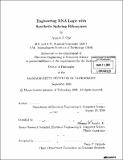Engineering RNA logic with synthetic splicing ribozymes
Author(s)
Che, Austin, 1979-
DownloadFull printable version (52.97Mb)
Alternative title
Engineering ribonucleic acid logic with synthetic splicing ribozymes
Other Contributors
Massachusetts Institute of Technology. Dept. of Electrical Engineering and Computer Science.
Advisor
Thomas F. Knight, Jr.
Terms of use
Metadata
Show full item recordAbstract
Reusable components, such as logic gates and code libraries, simplify the design and implementation of electronic circuits and computer programs. The engineering of biological systems would benefit also from reusable components. In this thesis, I show the utility of splicing ribozymes for the biological engineer. Ribozymes allow the engineer to manipulate existing biological systems and to program self-modifying RNA systems. In addition, splicing ribozymes are easy to engineer, malleable, modular, and scalable. I used the model ribozyme from Tetrahymena to explore the principles behind engineering biological splicing systems in vivo. I show that the core ribozyme is modular and functions properly in many different contexts. Simple base pairing rules and computational RNA folding can predict splicing efficiency in bacterial cells. To test our understanding of the ribozyme, I generated synthetic ribozymes by manipulating the primary sequence while maintaining the secondary structure. Results indicate that our biochemical understanding of the ribozyme is accurate enough to support engineering. Splicing ribozymes can form core components in an all-RNA logic system. I developed biological transzystors, switches analogous to electrical transistors. Transzystors can use any trans-RNA as input and any RNA as output, allowing the genetic reading of RNA levels. I also show the ribozyme can write RNA using the trans-splicing reaction. (cont.) Trans-splicing provides an easy mechanism to hook into an existing biological system and patch its operation. The generality of these ribozymes for a wide set of applications makes them promising tools for synthetic biology. Keywords: synthetic biology, RNA, Tetrahymena, ribozyme, splicing, transzystor.
Description
Thesis (Ph. D.)--Massachusetts Institute of Technology, Dept. of Electrical Engineering and Computer Science, 2008. Includes bibliographical references (p. 169-185).
Date issued
2008Department
Massachusetts Institute of Technology. Department of Electrical Engineering and Computer SciencePublisher
Massachusetts Institute of Technology
Keywords
Electrical Engineering and Computer Science.